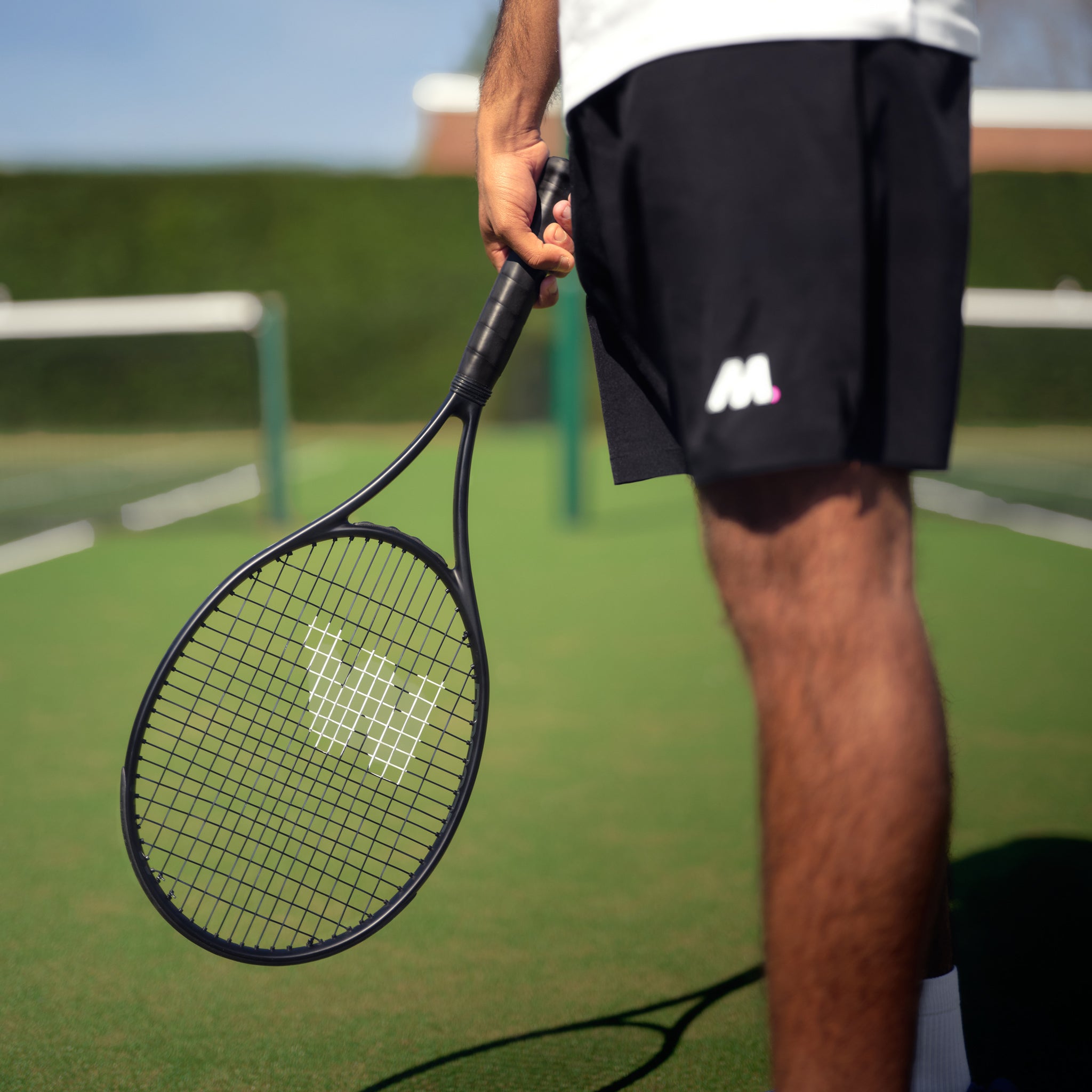
Whether you’re stepping onto a court for the first time or returning after a long break, it can feel a little intimidating. At Mantis, we know the world of UK club tennis is far more accessible and welcoming than you might think. Don't just picture a place with nets and racquets; think of it as a community hub, built around a shared love for the game. It’s where you’ll find everything from a relaxed social hit-about to fiercely competitive league matches. For a deeper dive, feel free to check out our resources on choosing the right tennis gear.
What Is Club Tennis?
At its simplest, club tennis is just organised tennis played within a membership-based club. It’s the perfect middle ground between a casual knock-up in the park and the demanding world of the professional tour. For an annual fee, you get access to courts, coaching, organised games, and, most importantly, a ready-made community of fellow players.
In this guide, we'll explore what makes club tennis a cornerstone of Britain's sporting culture and why it's enjoying such a boom in popularity. We’ll give you a real sense of the atmosphere you can expect, the connections you can build, and exactly how to get started.
This setup provides a fantastic, supportive environment for players to grow. Whether you want to sharpen your serve, compete in local leagues, or just find a regular, friendly game, a club offers the structure to make it happen.
A Thriving and Growing Community
The appeal of club tennis has really taken off in recent years. More and more people are discovering the brilliant physical and social benefits of the sport, leading to a noticeable surge in players hitting the courts across the country. And this isn't just a gut feeling; the numbers tell the same story.
According to the Lawn Tennis Association (LTA), there was a massive 43% growth in adult tennis players in 2022, jumping from 3.3 million to 4.7 million. Over two million of these adults are now playing monthly—the highest figure since the LTA started keeping track. The growth was especially strong among 16 to 34-year-olds, proving a whole new generation is getting hooked on the sport. You can read more about this tennis popularity surge on RacketBusiness.com
This boom translates into a more vibrant and diverse club scene. Today’s clubs are so much more than just facilities; they're social centres buzzing with all sorts of activities.
A tennis club offers a unique blend of competition, fitness, and camaraderie. It’s a place where you can challenge yourself on the court and build lasting friendships off it, creating a balanced and fulfilling sporting life.

The Atmosphere and Benefits
When you join a club, you become part of something much bigger than just your own game. The atmosphere is usually friendly and encouraging, designed to make everyone feel welcome, no matter their skill level.
Here’s a taste of what you can generally expect:
- Structured Social Play: Most clubs run "club nights" or "social tennis" sessions. These are brilliant drop-in events where you can mix in and play doubles with different members, making it super easy to meet people.
- Competitive Opportunities: If you've got a competitive streak, clubs are the place to be. You'll find internal box leagues, club championships, and even the chance to represent the club in local or county leagues.
- Professional Coaching: Clubs are magnets for qualified coaches. They offer everything from one-to-one lessons and group clinics to fun programmes like Cardio Tennis, all designed to help you improve.
- Community Events: The fun doesn't stop when you walk off the court. Clubs often host social events like summer barbecues, quiz nights, and annual dinners, which really strengthen the bonds between members.
Understanding the UK Club Tennis Ecosystem
When you join a local tennis club, you're not just getting access to a court; you're plugging into a nationwide network. Behind the scenes of every great club tennis experience is a robust national framework, put in place to ensure quality, safety, and a consistent standard no matter where you play.
At the very centre of this world is the Lawn Tennis Association (LTA), the official governing body for tennis in Great Britain. Think of the LTA as the guardian of the sport, setting the benchmarks that clubs need to hit to become officially recognised. For a deeper dive into the gear you'll need on court, Mantis has a fantastic guide to tennis rackets.
This official recognition is known as LTA accreditation, and it's a seal of approval that tells you a club is operating at a high standard. It’s not just a piece of paper; it’s a genuine commitment to providing a safe, welcoming, and well-managed home for players of all stripes.
The Role of LTA Accreditation
So, what does it really mean when you see a club is LTA accredited? In short, it’s a huge reassurance. It tells you the club has ticked all the boxes on a strict set of criteria, covering everything from the condition of the courts to the qualifications of the coaching team.
For you as a member, this translates into real-world benefits and, frankly, peace of mind. You know you're joining a place that takes its responsibilities seriously and is genuinely dedicated to giving you a quality experience on and off the court.
This system creates a reliable network of clubs across the UK, making it far easier to find a venue you can trust.
LTA accreditation is more than just a badge of honour; it's a promise to members. It guarantees that a club adheres to best practices in safeguarding, coaching, facility management, and inclusivity, creating a trustworthy and high-quality environment for everyone.
It’s this formal structure that ensures the things that matter are being managed properly, which directly shapes your time at the club.
What Accreditation Guarantees You
So, what’s in it for you? LTA accreditation directly impacts several key areas of club life, making sure you get the most out of your membership.
- Qualified Coaching: Every coach at an accredited club must be LTA qualified and accredited. This means they have up-to-date training, a valid DBS check, and first aid certification. You can be confident you’re getting instruction that is both effective and safe.
- Safeguarding Standards: Accredited clubs must have a trained Welfare Officer and solid safeguarding policies. This is absolutely crucial for junior programmes but also creates a secure environment for all members.
- Player Insurance: This is an often-overlooked perk. Membership at an LTA accredited club usually includes personal accident insurance for when you're playing, giving you protection in case of an injury.
- Facility Maintenance: The accreditation process involves checking the quality and safety of the facilities. This ensures courts, clubhouses, and other amenities are kept in good nick and are fit for purpose.
- Inclusive Environment: An LTA accredited club is committed to diversity and inclusion. This helps build a welcoming atmosphere where people from all backgrounds can feel comfortable and just enjoy the game.
These guarantees really elevate a simple membership into a secure and worthwhile investment in your sport.

Types of Clubs in the National Network
The UK’s club tennis scene is wonderfully diverse, with something for pretty much everyone.
You've got your smaller community clubs, which are often the true heart of local tennis. They offer a friendly, social atmosphere and are usually very affordable. These clubs are typically run by passionate members who are focused on getting more people to pick up a racket.
Then you have the large multi-sport centres. These venues often provide a much broader range of facilities, like gyms, swimming pools, and different court surfaces (clay, grass, hard courts). They tend to have extensive coaching programmes and host major tournaments, attracting more competitive players.
But regardless of their size or focus, all accredited clubs are connected through the LTA’s framework of competitions and development pathways. This integrated system means a player can progress from a local club league all the way to county-level competitions and beyond, creating a clear route for anyone with the ambition to follow their passion.
Finding the Right Tennis Club for You
Choosing a tennis club is a bit like buying a new pair of trainers; the right fit is everything. It can make or break your comfort, your performance, and ultimately, how much you enjoy the game. With more and more people looking for organised ways to play, now is a brilliant time to see what’s out there.
A great place to start is our own resource page, where you can find a comprehensive list of LTA-accredited clubs and coaches Mantis partners with. It’s all about matching your own goals, budget, and what you want from your tennis with what a club can offer. Whether you're chasing competitive league glory or just want a relaxed hit on a Sunday morning, there’s a club for you.
What to Look for in a Club
Before you even think about signing on the dotted line, you need to look past the price tag. Every club has its own personality, its own vibe. Some are all about high-stakes competition, with intense team practices and a packed league schedule. Others are far more laid-back, focusing on social events and casual, friendly games.
So, what should be on your checklist?
- Court Surfaces: Think about what you like to play on. Do you love the slide of a clay court, the classic feel of grass, or the reliability of a hard court? Most UK clubs have all-weather hard courts, but it’s worth checking if they offer other surfaces that might suit your style of play.
- The Coaching Team: Have a look at the coaches. Are they LTA-accredited? More importantly, do they offer the kind of programmes that fit your needs? This could be anything from group clinics and cardio tennis to one-on-one lessons for fine-tuning your technique.
- The Social Scene: A club is often more than just a place to play tennis. Check the club's calendar for things like social tennis sessions, barbecues, or quiz nights. A buzzing social atmosphere can be a massive part of the experience, turning a sports club into a genuine community.
- Facilities: Don’t forget the practical stuff. What’s the clubhouse like? Are the changing rooms clean and modern? Is there a bar or café for a post-match debrief? These little things really add up to make your time there more enjoyable.
The Joining Process Demystified
Don't be intimidated by the idea of joining a club. The process is usually very simple and designed to be as welcoming as possible. After all, clubs are always keen to bring new people into the fold.
Here’s a typical rundown of the steps:
- Arrange a Visit: Just give them a call and ask for a quick tour. It’s your best chance to see the courts, meet a few people, and get a proper feel for the place.
- Try a Taster Session: Most clubs will offer a free trial or a "taster" session. You might be invited to a social tennis evening or an introductory coaching clinic. It’s a no-pressure way to see if you like it before committing.
- Look at Membership Options: Clubs usually have a few different membership tiers. You might find full access, off-peak, junior, or family packages. Think about how often you'll realistically play and pick the one that makes sense for you.
- Sign Up!: Once you’ve made your choice, it’s just a case of filling out a form and paying your fees. Then you’re in! You’re officially a member and ready to get on court.
Deciding on the best membership can feel tricky, but this simple decision tree can point you in the right direction based on how often you plan to play.
As you can see, your commitment level and whether you're looking for coaching are the biggest factors in finding the most cost-effective option for you.
Comparing Tennis Club Membership Types
To help you weigh up the options, it’s useful to see the common membership types laid out side-by-side. Most clubs will offer a variation of these, so understanding the basics will put you in a great position to choose wisely.
| Membership Type | Typical Inclusions | Best For | Average Cost Range (Annual) |
|---|---|---|---|
| Full Adult | Unlimited court booking, league play, social events | Serious players who want to play anytime and compete | £250 - £600+ |
| Off-Peak | Court access during weekdays or specific hours | Players with flexible schedules, retirees, or those on a budget | £150 - £350 |
| Junior/Student | Access for under 18s or those in full-time education | Young players looking for coaching and a social outlet | £50 - £150 |
| Family | Membership for two adults and 1-2 children | Families who all play and want a cost-effective bundle | £500 - £1,000+ |
| Social | Access to the clubhouse, bar, and social events only | Non-playing partners or community members | £25 - £75 |
| Pay and Play | No annual fee, pay per court booking | Very infrequent players or beginners not ready to commit | N/A (Pay per hour) |
Ultimately, the best choice boils down to how tennis fits into your life. Don't just look at the price; consider the value you'll get based on your playing habits.
Membership Trends in the UK
It's clear that the appeal of a proper, structured playing environment is growing. Club membership among tennis players in England has been climbing steadily for years.
Between the 2016/17 and 2021/22 seasons, the percentage of tennis players who were club members rose to 35.3%. In real terms, that’s about 177,551 adult members across England in that period alone. This shift shows that more and more players are realising the benefits that club life offers.
Choosing a club is a personal decision. Take your time, visit a few different places, and trust your gut. The right club will feel like a second home—a place where you're excited to spend your time, both on and off the court.
Taking Your Game to the Next Level with Club Training
Think of a tennis club as your personal development lab—a place where raw potential is honed into real skill and on-court confidence. A good club does more than just give you a court to play on; its entire structure is built to help you get better, whatever your starting point. Behind the scenes, many clubs now use efficient class booking systems to keep everything running smoothly, so you can easily find and book the sessions you need. This organised approach opens up a whole spectrum of training options for every type of player.
For most people, the most direct route to improvement is through coaching. Clubs are a hotbed for qualified professionals who can take your game apart, piece by piece, and build it back stronger. One-on-one sessions are priceless if you're after focused, in-depth feedback. We've seen first-hand how personalised coaching can quickly fix those stubborn bad habits, sharpen technique, and help you build a match strategy that plays to your strengths. For a deeper dive into this, Mantis has a great article on the benefits of tennis lessons for adults.
Structured Training Options
But it’s not all about private coaching. Most clubs offer a fantastic mix of group sessions that blend skill development with fitness and a bit of social fun, making for a really dynamic way to learn.
These sessions are brilliant for anyone who feeds off the energy of a group and enjoys learning with others. They're also a more wallet-friendly way to get professional tips while meeting new people to hit with.
You'll typically find a few popular formats:
- Group Clinics: These are focused sessions dedicated to a single part of the game—like mastering your kick serve, dialling in your backhand, or getting comfortable at the net. They bring together players of a similar standard to work on a common goal.
- Cardio Tennis: This is a high-octane fitness class on a tennis court. It’s all about getting your heart rate up with non-stop drills set to music. It's less about perfect form and more about hitting tons of balls and improving your footwork.
- Drill Sessions: Led by a coach, these are fast-paced and repetitive. The goal is to build muscle memory for key shots like volleys, smashes, and groundstrokes until they become second nature.
Finding the Right Coach for You
Choosing the right coach is a huge part of your tennis journey. It goes beyond just their qualifications; you need to find a personality and teaching style that genuinely clicks with you. A great coach is more like a mentor—they take the time to understand your goals and know exactly how to motivate you.
When you're looking, don't be afraid to ask for a taster session. It’s the best way to see how they communicate and get a feel for their methods. The best coaches are fantastic listeners who tailor their approach to the player in front of them, rather than just rolling out a one-size-fits-all plan.
A good coach can show you how to hit a forehand. A great coach will help you understand why you hit it that way and give you the tools to self-correct during a match. Their job is to eventually make themselves redundant.
This sense of empowerment is the hallmark of truly effective coaching and is the key to long-term improvement.
Putting Your Skills to the Test
Drills and lessons are one thing, but the real acid test is applying those skills when it matters. This is where a club's competitive side becomes your best friend. It provides a safe, structured way to see where you’re at and track your progress.
These internal competitions are the perfect stepping stone between a friendly hit and a formal league match. You get all the pressure of a real game, but in a familiar and supportive environment.
Here’s how clubs help turn practice into performance:
- Club Ladders: A simple and brilliant system. Players can challenge those ranked just above them. If you win, you swap places. It creates a constantly shifting ranking that encourages everyone to play regularly.
- Box Leagues: Members are put into small groups (or 'boxes') with others of a similar ability. You play everyone in your box over a few weeks, and the winners often get promoted to a tougher box for the next round.
- Club Tournaments: These are the big ones! Usually held annually, they feature events for singles, doubles, and mixed doubles. They create a real buzz around the club and give everyone a clear goal to work towards all year.
Getting involved in these events teaches you how to handle nerves, think on your feet, and adapt to different playing styles. It's in these moments that all those lessons from the practice court really start to click, turning you into a smarter, more resilient player.
Choosing Your Essential Tennis Gear
Walking into a sports shop and staring at a wall of tennis gear can be pretty intimidating. If you're new to the game, it's easy to just reach for the most expensive racket or the one you've seen your favourite pro use on TV. But here's a little secret from those of us who've been around the court a while: the best gear isn't about the flashy brand names. It's about finding what actually works for you and your game.
Let’s cut through the noise. At Mantis, we'll break down how to invest in equipment that won't just look the part, but will genuinely help you play better and, most importantly, have more fun.
Of course, the most personal and crucial piece of kit you'll buy is your racket. Think of it as an extension of your arm. What feels perfect for a heavy-hitting baseliner will feel like a clumsy plank of wood to a player who relies on touch and finesse at the net. Understanding a few simple characteristics is all it takes to find your match.
Selecting Your Perfect Racket
When you're trying to find the right racket, it really boils down to three things: its head size, weight, and balance. Nailing this combination will make a world of difference to how you feel and play on court.
- Head Size: A bigger head size (think over 100 square inches) gives you a larger ‘sweet spot’. This makes it much more forgiving if you don't hit the ball dead centre every time, which is a massive help for beginners. More advanced players often prefer a smaller head for the extra control it gives them.
- Weight: Heavier rackets (anything over 310g) pack more punch and feel more stable when you're hitting the ball hard. The downside is that they can be tougher to swing. Lighter rackets are much easier to get moving, which is great when you're still developing your swing or love to react quickly.
- Balance: Is the weight in the head or the handle? A 'head-light' racket, with more weight in the handle, is nimble and brilliant for quick volleys at the net. A 'head-heavy' one gives you more oomph on your groundstrokes, making it a solid choice for baseline players.
Your racket should feel like a natural partner, not a tool you’re constantly fighting with. The absolute best way to find 'the one' is to try a few out. Ask your club's pro shop if you can demo a few different models before you commit.
Shoes and Strings: The Unsung Heroes
The racket might get all the glory, but your shoes and strings are the real workhorses of your tennis kit. Your footwear is your connection to the court, and the right pair is non-negotiable for preventing injuries and playing your best. Tennis shoes are built for the sharp, side-to-side movements of the game, giving you a level of support that your everyday running trainers just can't match.
Make sure the sole (the outsole) is right for your club's courts. Hard courts will chew through soft soles, so you need something durable. If you're playing on clay, you'll want a classic herringbone pattern to get the best grip.
And don't forget your strings! The type of string and how tightly it's strung can completely transform how a racket feels and performs.
- String Type: You've got a few main choices. Natural gut offers an amazing feel, polyester is durable and great for hard hitters needing control, and multifilament is a fantastic all-round, arm-friendly option perfect for most club players.
- String Tension: It’s a simple trade-off. Tighter strings give you more control, while looser strings generate more power. A good place to start is in the middle of the recommended range, maybe around 55 lbs, and then you can tweak it as you get a better feel for what you like.
Finding the right gear is a bit of a journey. But by understanding these fundamentals, you’re already well on your way to making smart choices that will help you grow as a player.
The Enduring Legacy of British Tennis Clubs
When you join a tennis club in the UK, you’re not just signing up for a court. You’re stepping into a story that stretches back for generations. Understanding this rich heritage gives every match a deeper meaning, connecting today’s players to a long and prestigious past. The history of club tennis is woven into the very fabric of British sport, and it’s a story that has evolved from exclusive Victorian high-society gatherings into the inclusive community hubs we know and love today.
This journey began in the late 19th century, when lawn tennis first captured the imagination of the upper classes. Clubs quickly became social epicentres, places where sport, tradition, and community spirit all came together. This laid the foundation for a culture that has been carefully preserved and passed down, shaping the unique character of British club life. It's a legacy built on more than just winning; it's about camaraderie and a shared passion for the game. We believe it is crucial to keep this history alive and thriving.
From Exclusive Lawns to Community Hubs
The evolution of club tennis really mirrors the UK's own social changes. In the beginning, clubs were often private, walled-off institutions accessible only to a select few. Over the decades, though, they began to open their doors, realising that the future of the sport depended on accessibility and developing talent from the ground up. This shift was fundamental, transforming tennis from an elite pastime into a sport for everyone.
Today, that spirit of inclusivity is what truly defines the modern British tennis club. They are vibrant, diverse communities where players of every age, background, and ability can find a home. These clubs are now crucial local hubs, fostering not just athletic talent but also the social connections that strengthen the wider community.
Joining a club is about becoming part of a continuous legacy. Every club championship, every social doubles match, adds another chapter to a story that has been unfolding for well over a century, preserving the traditions that make the sport so special.
Iconic Clubs and Their Lasting Impact
Of course, some institutions have played a central role in this story, shaping the sport and nurturing legendary players along the way. The history of tennis clubs in the UK is deeply intertwined with prestigious venues like The Queen’s Club in London, which has been crucial in developing and promoting club tennis. Established in 1887 and named after Queen Victoria, it has hosted the Queen’s Club Championships—one of the world's oldest and most respected grass-court tournaments—since 1890.
Its importance can't be overstated. Countless Wimbledon champions, including titans like John McEnroe, Rafael Nadal, Andy Murray, and Carlos Alcaraz, won at Queen's in the very same year they lifted the Wimbledon trophy.
These iconic clubs did more than just host tournaments; they set the standard for what a tennis club could be. They established traditions, popularised competitive formats, and inspired the creation of hundreds of smaller clubs across the country. This network is the bedrock of British tennis, a testament to the enduring vision of its founders. By joining a club today, you’re playing your part in this living history, ensuring the legacy continues to thrive for generations to come.
Your Club Tennis Questions Answered
Stepping into the world of club tennis for the first time naturally comes with a few questions. We've put together some clear, straightforward answers to the things we get asked most often.
Think of this as your quick-start guide to the practical side of joining a club, making sure you feel confident and ready to hit the court. And if you're wondering about gear, don't forget Mantis has in-depth guides, like how to choose the perfect tennis racket for your style of play.
Do I Need to Be an Advanced Player to Join a Club?
Absolutely not. This is one of the biggest myths out there. UK tennis clubs are built for everyone, from people who've never held a racket before to seasoned league players.
Most clubs run specific programmes designed to welcome newcomers. You'll find things like beginner coaching courses and super-relaxed social hitting sessions, all aimed at helping you settle in and find your feet. There really is a spot for every skill level.
What Is the Difference Between Social Tennis and Team Practice?
Think of social tennis (often called 'club night') as the fun, relaxed side of club life. It’s usually a drop-in session where you mix in for friendly doubles with lots of different members. It's the best way to meet people and just enjoy a game without any pressure.
Team practice, on the other hand, is a different beast altogether. These sessions are for players who compete for the club in local or county leagues. Expect structured drills, tactical work, and focused match play, often run by a team captain or coach. It’s all about getting sharp for competitive matches.
Can I Play at a Club Without a Full Membership?
Yes, most clubs understand you might want to test the waters before diving in. They usually offer a few flexible ways to play without committing to a full year's membership.
Here are a few common options to look out for:
- Pay and Play: Simply book a court and pay for the time you use. It's a great no-strings-attached option.
- Off-Peak Memberships: If you can play during the day on weekdays, this is often a much cheaper way to get access.
- Guest Passes: Members can typically bring a guest along for a small fee, which is a perfect way to get a feel for the place.
What's the deal with LTA Advantage? This is the Lawn Tennis Association's scheme for UK players. While not essential for a casual knockabout, it's a must if you want to play in official leagues or tournaments. It gives you a World Tennis Number (a bit like a golf handicap) and entry into the Wimbledon ticket ballot. Most club memberships include it automatically.
At Mantis, we create high-performance tennis gear for players dedicated to improving their game. Discover our range of rackets, strings, and accessories, all engineered for precision and power, at https://mantissport.com.










